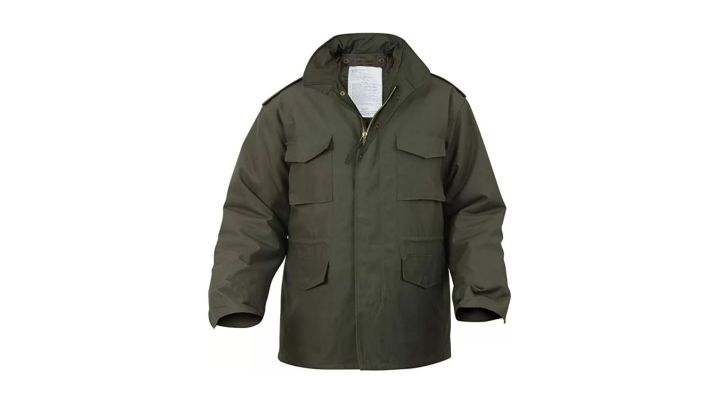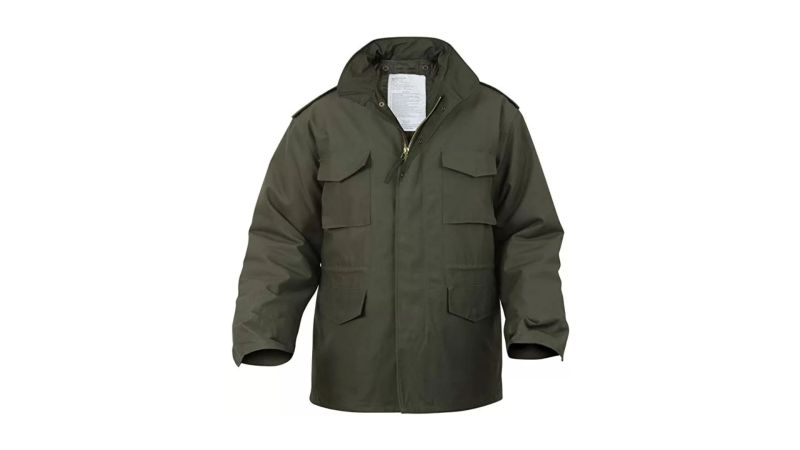We may earn revenue from the products available on this page and participate in affiliate programs.

Few things can surpass the peace of mind that comes with going into the outdoors knowing you have a reliable field jacket.
Originally adopted by the U.S. military in (unsurprisingly) 1965, the M-65 field jacket gained renown and popularity during the Vietnam War, where it was standard issue for service members deployed to Southeast Asia. The impact of the war was viscerally represented to American society by soldiers returning home still clinging to the jacket that protected them from the many elements overseas. Worn by veterans, Rambo, and so many others, the field jacket became an iconic representation of the U.S. military during that chapter of American history, and its cultural footprint remains to this day.
What makes a good field jacket? By historical precedent, a field jacket is a durable, rugged coat that’s loaded with pocket space, all while keeping out most inclement weather. However, in an industry flooded with reproductions, knockoffs, and emulations, not all jackets are created equal. That’s why we’ve taken the time here at Task & Purpose to provide you with a list of some of the best options out there to keep the elements off your back and help you narrow the field down to a few winners so you can buy with confidence. Let’s get to it, shall we?
Methodology
When trying to select our suggestions for this article, I looked at what makes a field jacket great: warmth, durability, and lots of pocket space. Historically, the field jacket was supposed to be something a soldier could wear in the field, pockets stuffed full of extra ammo or rations, and keeping the weather off their back. I stuck with companies who have lived up to that expectation historically and products that fit that design philosophy. I also pored over some of the most popular options, some of the most heavily-advertised results on social media and in Google search results, and weeded through those options that were most obviously cheap knock-offs.
When you’ve spent enough time outdoors and at hard labor, certain design choices and materials stand out as being of lesser quality. Even beyond my own experience in the U.S. Army, I’ve spent years personally buying a wide range of jackets from a variety of manufacturers, and have learned some little tricks to be able to tell how a product will perform over the long term. Little things like how a jacket is cut can tell you how much range of motion you’re going to get, or what materials let in too much water or don’t breathe as well become obvious.
Best Overall
Filson 3-Layer Field Jacket
Best Value
Duluth Trading Co Flannel-Lined Limber Jac
Editor’s Choice
Rothco M-65 Field Jacket
Best for Women
Outback Trading Co Sheila's Delight
Best Waterproof
Dri Duck Field Jacket
Best Tactical
TAD M-65 Field Jacket
Best Insulated
Carhartt Yukon Extremes Insulated Coat
Best Everyday Field Jacket
Kuhl M's Kollusion Fleece Lined Jacket
Our verdict on field jackets
With so many field jackets on the market, it’s easy to get overwhelmed. With the Filson 3-layer, you have a guaranteed lifelong outer layer that works in any situation, and the Duluth Firehose Shirtjac can be your bargain-priced do-anything coat. Go forward and purchase with confidence.
What to consider when buying a field jacket
Types of field jackets
M-65
This is the classic military jacket. These jackets all share the hallmarks of the original design: the stowable hood, large pockets, and a detachable liner for extra warmth in cold conditions. They’re usually a cotton/poly blend for better water resistance and durability, and many are treated for additional waterproofing.
The nice thing about an M-65 is the tried-and-true design. It’s been field-tested to death, so you know it’s going to work when you most need it without fail. Another benefit? The internal liner is just a woobie shaped like a coat, and it’s impossible to be unhappy about that. Everybody loves their woobie.
Hunting jackets
Hunting field jackets tend to deviate a bit from the classic M-65 design philosophy, with synthetic materials or oilskin being more prevalent and hoods being less common, but they keep a lot of the features we love. Lots of large pockets, superb warmth, and excellent weather resistance are all hallmarks.
Another difference is the fit — where the classic design is deliberately oversized and baggy, hunting jackets tend to be a little more form-fitting and snug. This helps avoid snagging on branches and underbrush as you move through the woods, but a good hunting jacket achieves this without sacrificing freedom of movement.
Workwear
Many workwear companies have their own field jacket style designs, but they can be a stark departure from the original design. As with hunting jackets, hoods are less common, and they often lack the abundant storage space as other options (the expectation being that you probably have a toolbag handy).
What they do give you is superb durability, high-quality construction, and — with the best workwear — excellent range of motion.
Key features of field jackets
Weather resistance
The most important feature of a good field jacket is that it’s going to keep the weather off your back. As implied by the name, it’s something you’re going to be using when you’re out in the field, so you want something that’s going to keep you warm and dry. Whether it’s hiking through the mountains, camping with your friends, or on a hunting excursion, you need to feel confident that rain, wind, and nature aren’t going to ruin the trip.
Durability
A good field jacket is also going to be holding up to whatever you’re doing. It should be able to resist abrasion, the elements, even light punctures if it’s well-constructed. Think of the original use of the field jacket — crawling around in the dirt, throwing yourself on the ground to avoid incoming fire, and combat wear and tear — and you get the idea.
Storage
Another vestige of the original, militant purpose of the field jacket is an emphasis on storage. The original M-65 jackets were designed to be oversized with huge pockets, allowing troops to stuff whatever ammo, medical supplies, and rations they might need on a patrol or extended field exercise without impeding their movement and mobility. A good field jacket should do the same for you, whatever you’re using it for.
Field jacket pricing
Like most quality, purpose-built jackets, they can run a little pricier than your average raincoat. A decent field jacket is going to run you a few hundred dollars. If you’re going to use it for a highly specialized purpose, or you’re going for exceptionally high quality, that price can quickly balloon.
Budget
For under $100, you’re typically going to see knock-off “fashion” designs that have the look, but none of the functionality.
Mid-range
Between $100 and $300, you’re usually looking at a reliable jacket that’s made out of quality materials. However, it may not hold up as well over the long term and may only be useful in a handful of environments.
Premium
Over $300, and you’ve likely got yourself something that will last you a lifetime with proper care and maintenance.
FAQs on field jackets
You’ve got questions. Task & Purpose has answers
Q: How warm are field jackets?
A: A good field jacket will keep you warm in all but the most extreme climates. Think of an average winter night in the Midwest and you’ve got the right idea.
Q: Are field jackets fashionable for men?
A: Absolutely. After hundreds of thousands of veterans brought them home from various wars, they have become fashion icons in their own right, and dozens of fashion companies make their own version.
Q: What is the current U.S. Army field jacket?
A: Tragically, the U.S. Army has moved on from field jackets and instead issues a multi-level cold-weather system consisting of a Gore-Tex shell, soft underlayer, and other layering options.
Q: What should I wear under a field jacket?
A: The best field jackets include the ubiquitous field jacket liner, a quilted insert that buttons to the inside of your field jacket to provide better insulation and comfort, and even better, feel just like your woobie.










